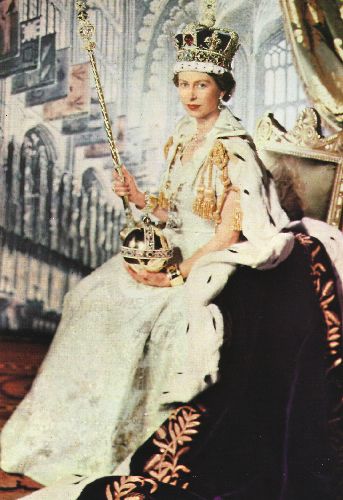By Pauline Weston Thomas for Fashion-Era.com
Queen Elizabeth Coronation Dress Design Brief
With the day of the coronation set for June 2 1953 the bustle of behind the scenes activity went on for some 16 months. Adequate seating, television coverage and careful route planning might be the making of the day for others, but for the Queen knowing her coronation robes would be comfortable and safely fastened throughout the long arduous day was of vital importance.
The new Queen had listened respectfully to her grandmother's advice about designs for a Coronation gown, but she had firm ideas of her own, especially of what it should not be. Her specifications to Norman Hartnell her chosen British designer were that the coronation dress should be on the lines of her wedding gown and be made of white satin. It was to be both regal and religious without exaggeration of shape.
With thoroughness, Hartnell researched the history and tradition of Coronation dresses, visiting the London Museum and the London Library and emerged with factual information.
The coronation gown had to stand out against a competitive background of colour and the brilliance of precious gems. Such a dress would also be destined to be historic and Hartnell wanted it to be his masterpiece that would appear as a great piece of costume history.
His mind teamed with all the possibilities from heraldic and floral emblems to thoughts of heavenly bodies and centuries old religious vestments. The ideas flowed onto paper and he made many trial sketches from which emerged eight painted designs. Together, the Queen and Hartnell discussed the designs which ranged from severely simple to highly elaborate.
Hartnell's Trial Designs for the Queen Dress - Coronation Robes
The first coronation dress design was for a very simply styled gown similar to that worn by Queen Victoria at her Coronation. The only decoration on the white satin was a Greek key design which formed an embroidered border on the hem and bodice.
The second design was a modern slim-fitting sheath gown, embroidered in gold and trimmed with black and white ermine tails at the hemline. The Queen rejected this as too form fitting.
The third was a crinoline style coronation dress of white satin, silver tissue and crusty silver lace, the whole shimmering with crystals and diamante.
The fourth was white satin embroidered with Madonna and arum lilies and encrusted with pendant pearls.
The fifth introduced colour and although the Queen was dubious about the design of violets, roses and wheat, she liked the departure from the traditional all white gown with just the addition of gold or silver.
The Queen very much approved of the sixth design which was the first of the emblematic Ideas. Spreading branches of oak leaves with acorns, were embroidered in gold, silver and copper bullion thread on a white satin background.
The seventh introduced the Tudor Rose of England, appliquéd in gold tissue and softly padded amidst looped fringes of golden crystals against white satin.
Finally, the eighth design was a variation of the seventh, but incorporating all the floral emblems of Great Britain. It pleased the Queen, but the fact that it was embroidered in silver and crystal caused her to remark that it closely resembled her wedding dress. Queen Victoria wore all white at her Coronation, but she was only eighteen and unmarried, whereas the Queen would be a twenty seven year old mother of two at her Coronation. The Queen thought the latter design would be ideal if Hartnell could introduce some colour. In a short time the necessary tints were applied and the coronation dress design was approved.
The Final Coronation Queen Dress Design
Then Prince Philip made the observation that his wife was Queen of the Commonwealth as well as Great Britain, so Hartnell was asked to draw up a ninth design which included the Dominion emblems.
Hartnell juggled with the eleven emblems until he arrived at a satisfactory arrangement within the design.
This is a sketch of the Coronation dress I made from looking at Hartnell's drawing which showed the placement of emblems.
If you click the thumbnail and print it out you may use it in school project class work as a Jubilee colouring picture of Her Majesty Queen Elizabeth 2nd's gown.
The Queen wore a Diadem to the Abbey before the coronation ceremony.

(Copyright © 1977 -2022. This picture may not be used as part of a CD or electronic device for sale purposes.)
Hartnell also checked them with the Garter King of Anno and was horrified to discover that the emblem for Wales was not a daffodil, but a dull vegetable, the leek.
The Garter flatly refused to allow the use of the daffodil. Hartnell finally 'borrowed' the leek on the cap of the Welsh Guards and his embroideresses interpreted it into an attractive motif using fine silks and diamante. The leek became a source of inspiration and most of the other emblems were interpreted in the same way.
With the completed emblem samples, Hartnell travelled to Sandringham where he showed the Queen his ninth design.
For England there was a Tudor Rose, embroidered in palest pink silk, pearls, gold and silver bullion and rose diamante.
The Wales the Welsh Leek, embroidered in white silk with leaves of palest green silk, was enhanced with diamante.
For Scotland the Thistle was worked in pale mauve silk and amethysts. The calyx was embroidered in reseda green silk, silver thread and diamante dewdrops.
The Irish emblem, the Shamrock, was embroidered in soft green silk, silver thread, bullion and diamante.
For Canada, the Maple Leaf was worked in green silk embroideries, veined in crystal and bordered with gold bullion.
The Australian Wattle flower, was, after countless attempts, successfully achieved with fuzzy mimosa yellow wool and green and gold foliage.
The Fern of New Zealand was embroidered in straight stitches using soft green silk and veined in silver and crystal.
The South African Protea was embroidered in shaded pink silk, each petal bordered with silver thread. The leaves of shaded green silk were embellished with rose diamante.
The Lotus flower of India was worked in seed pearls and diamante, and mother of pearl embroidered petals, whilst the Lotus flower of Ceylon was of opals, mother of pearl, diamante and soft green silk.
Pakistan's three emblems are Wheat, Cotton and Jute. The Wheat was in oat-shaped diamante and fronds of golden crystal. The Jute was embroidered as a spray of leaves in green silk and golden thread. Finally, the Cotton blossom was worked in silver with leaves of green silk.
The Queen liked the interpretation of each emblem and asked only that the green of the Shamrock be subdued.
The Making of the Coronation Dress
Once Hartnell had the Queen's approval, work commenced on the white satin which had been obtained from Lady Hart Dyke's silk farm at Lullington Castle. Six embroideresses worked in utmost secrecy and all involved on the project were closely surveilled until Coronation day.
By Christmas the Coronation dress, constructed by three girls, was ready for its first fitting. Madame Isabelle, who was in charge of the construction of the dress, had experienced some difficulties in getting the weighty bejewelled skirt to fall correctly.
On its wooden model the skirt of the dress swung to one side. She solved the problem by backing the silk fabric with cream taffeta throughout and reinforced it with three layers of horsehair. The additional support not only solved the problem, but also gave the skirt a certain stability which dispersed the weight of -the beading over the whole of the bell-shape, making it as light as air to wear.
Rehearsals for Movement and Make Up
As the Coronation drew nearer the Queen and her six Maids of Honour rehearsed the scenes that lay ahead.
With a lengthy piece of sheeting attached to the Queen's shoulders, representing the velvet train, they rehearsed folding, holding, halting, walking and getting in and out of a mock coach made of an arrangement of chairs.
The Imperial State Crown was also secretly taken to Buckingham Palace, where the Queen wore the seven pound crown for the best part of a day.
She wore It at her desk, for afternoon tea and to read the newspaper.
This helped her to become accustomed to the shape, weight and balance of it.
Amongst other rehearsals were trial and error make-up experiments on a model of similar looks and colouring as the Queen.
These experiments eventually produced a make-up that would look equally well under the bright yellow lighting of the television arc lamps in the Abbey, as in the rose-tinted lighting of the State Coach. The make-up also had to look just as suitable with the crimson robe the Queen was to wear on her way to the Abbey and look equally good with the purple velvet robe she would be wearing on the return journey.
Three days before the Coronation, Hartnell delivered the Coronation gown to the Palace.
When the Queen tried it on she used one word to describe it - 'Glorious'. Unknown to her, Hartnell had embroidered an extra four-leaved Shamrock on the left side of her dress - a small omen for good fortune - which the Queen's left hand would often touch throughout the day.
Coronation of Queen Elizabeth ii - June 2nd 1953
As dawn broke on Coronation day people were preparing in their own ways for a very special day whether in town or country or in London. There the streets were lined with well wishers and loyal subjects keen to see history made and be part of an atmosphere that falls so rarely in a lifetime for us all.
Millions in the UK and elsewhere in the world watched the Coronation on a friend or neighbour's small screen black and white television set. For millions it was the first time they ever saw television and shortly after sales of television sets in the UK boomed, bringing ideas and fashions to the masses.
The Guests Arrive at Westminster Abbey
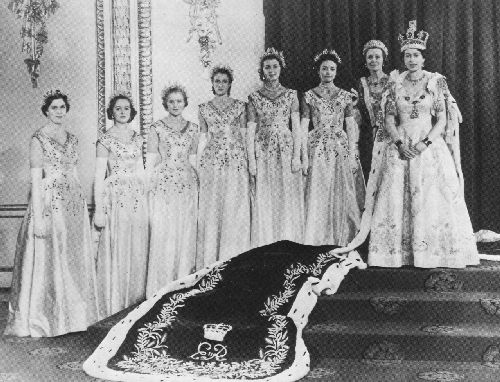
At the Abbey, on Coronation Day June 2nd 1953, guests had been arriving since early morning, so that by 8.30 a.m. the doors were closed for the first of the Royal processions which included Royalty from home and abroad.
Hartnell had dressed the whole of the British Royal Family, the Maids of Honour and the Ladies of the Bedchamber. All were treated as a theatre cast, with the Queen as leading lady and the Abbey as the background set.
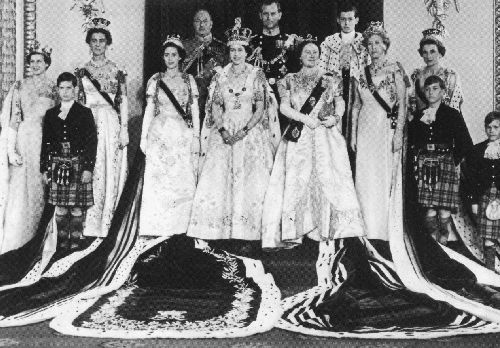
As the Royal processions of H. R. H. Duchess of Kent, H. R. H. Princess Alexandra, H. R. H. Princess Margaret and the Queen Mother each arrived, each one gave the impression of being more magnificent than the former, so that they set the scene for the Queen's procession.
The Queen's Arrival at Westminster Abbey
Shortly before 11 a.m. the Queen arrived at the Abbey. She was assisted by six Maids of Honour, each Maid wearing white satin, embroidered with pearl blossoms and trails of small golden leaves.
The Queen Robe of State of Crimson Velvet
The Maids carried the six-yard long Robe of State of Crimson Velvet which was attached to the Queen's shoulders. The robe, often incorrectly called the Parliament Robe, is a crimson velvet mantle edged with ermine and two rows of hand-made embroidered gold lace and gold filigree work.
The queen robe was made by Messrs. Ede and Ravenscroft of Chancery Lane, London. The velvet had been hand-woven by Warners of Braintree, Essex, from silk supplied by Lady Hart Dyke of Lullington Castle.
Hand-weaving of velvet is now a very rare process today as power-driven machinery has superseded this operation in most places. The traditional design of the robe was modified so that the robe would be narrower in width at the shoulders and show the splendid Coronation gown to advantage, whilst, at the same time relieving the Queen of some of the mantle's weight.
The Queen's Colobium Sindonis Dress
Promptly at 11 a. m. the Coronation ceremony commenced, and as the moment of anointing drew nearer the six Maids of Honour disrobed the Queen of her Robe of Crimson Velvet and removed her jewellery.
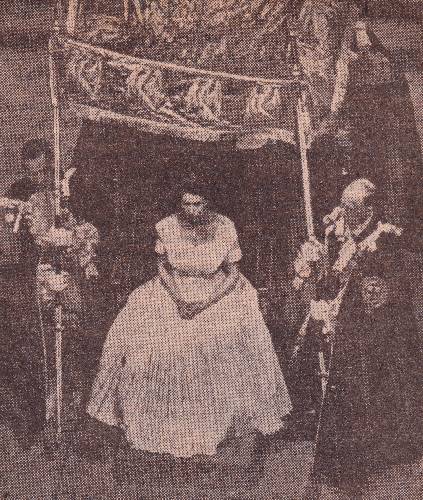
Removed of all vain-glorious possessions, the Queen's magnificent dress was covered with a plain white linen robe called a colobium sindonis. Hartnell designed the starkly simple dress, devoid of lace or embellishment, to cover completely the short-sleeved, heart-necklined gown.
The sun-ray pleated pure white colobium sindonis dress fastened at the back like a pinafore. Hartnell, who always considered the practicalities of dressing Royalty knew that a zip could fail at a critical moment and be difficult to manipulate by the gloved hands of the Mistress of the Robes.
Wisely, he chose to incorporate large buttonholes with equally large buttons. At the moment of robing and disrobing there was no fumbling.
The Coronation dress had a zip-fastener down the back plus the additional support of a series of tiny hooks and eyes, in case of a zip failure. It's little details like this that make Royal ceremonies flow so smoothly. The ceremony continued, throughout which the Queen was continually robed and disrobed, according to ancient custom.
The Queen Robe of Purple Velvet
Finally, disrobed of all liturgical and ceremonial vestments she donned the exquisite Robe of Purple Velvet before leaving Westminster Abbey. Like the Robe of State, this 6 yard train was made by Ede and Ravenscroft and woven at Warners of Braintree. It was also cut on narrower lines to allow the Coronation gown to be shown off and reduce the burden of weight.
Unlike the Robe of Crimson Velvet, the Robe of Purple Velvet was not lined throughout with ermine, but with white silk instead. Again this reduced the weight further.
Ermine was used to line only the edge of the robe and to make the cape; the skins having been specially obtained from Canada, one of the Commonwealth countries.
The Royal School of Needlework was responsible for the embroidery worked in gold bullion thread and the design is a simple one which has been beautifully executed. Ears of Wheat with leaves and stalks intertwine down both sides of the train, culminating in a solid gold embroidered crown with the symbol E. R.
The Silver Jubilee Exhibitions of Royal Dress
I was fortunate to be able to see this magnificent work of art at a special Silver Jubilee Exhibition at the Royal College of Art in London. The purple velvet was so luxurious that it took my breath away.
Despite many other wonderful exhibits, this Robe of Purple Velvet was the 'piece de resistance' of the exhibition. People kept returning to look at the exquisite embroidery gold bullion raised high amid the deep deep velvety pile. It was so sumptuous and a beautiful textile.
To my way of thinking, this rich purple velvet robe far surpassed the beauty of the Queen's Coronation gown which was also on display in the London Museum at the time of my visit.
The embroidery on the Coronation gown is very very pastel with only the merest, most subtle trace of colour and the overall effect is of a glass like iridescence. The picture of the Queen in her full regalia shows the correct colour of the beading and depicts the dress exactly as it must have been the day the photograph was taken.
There is no doubt that a garment like this can only be truly appreciated on the moving human form with the beadwork shimmering and shifting in the light.
The Golden Jubilee Exhibitions of Royal Gowns and Robes 2002
In every coronation film I've ever seen I can only think how majestic and poised the youthful Queen looked on her Coronation day. That the day had been a huge success must have been obvious to the Royal Family and the fact that 50 years has passed since the event will this year make it an event to celebrate throughout the UK.
The Golden Jubilee meant that Museums, Libraries, Schools and Galleries nationwide had displays relating to Royalty and royal dress. If you are a royal fan make the most of any opportunity you get to see exhibitions of this nature. It seems that as the years move on and interest in the Royal family wanes within the UK there will be less chance to experience celebrations of this type and such showcase presentations of pomp and circumstance.
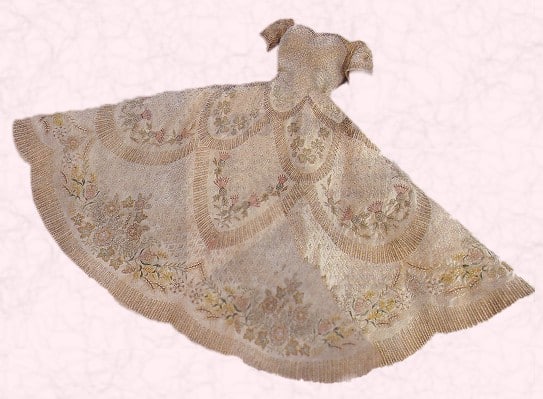
Link to State Apartments, Kensington Palace site where royal ceremonial robes are kept.
Note - This page on the Queen's Coronation dress is based on some content taken from a dissertation called: Her Majesty Queen Elizabeth II - The Splendour Of Regal Wear which I wrote in 1978.
The dissertation looked at the symbolism behind the decorative embellishment on ceremonial dresses worn by the Queen and how the decoration on those dresses could be used as a starting point to create fresh new design ideas.
Go straight back to Hartnell's Design of the Queen's Wedding Dress
